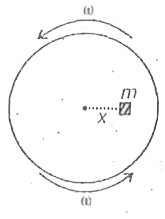A block of mass m1 is lying on the edge of a rough table. The coefficient of friction between the block and the table is μ. Another block of massm2 is lying on another horizontal smooth table. The two block are connected by a horizontal spring of force constant K. Block of mass m2 is pulled to the right with a constant horizontal force F. (a) Find the maximum value of F for which the block of mass m1 does not fall off the edge. (b) Calculate the maximum speed that m2 can acquire under condition that m1 does not fall.

The correct Answer is:(a)μm1g2
(b) μm1g21√m2k
Step by step video, text & image solution for A block of mass m_1 is lying on the edge of a rough table. The coefficient of friction between the block and the table is mu. Another block of massm_2 is lying on another horizontal smooth table. The two block are connected by a horizontal spring of force constant K. Block of mass m_2 is pulled to the right with a constant horizontal force F. (a) Find the maximum value of F for which the block of mass m1 does not fall off the edge. (b) Calculate the maximum speed that m_2 can acquire under condition that m_1 does not fall. by Physics experts to help you in doubts & scoring excellent marks in Class 11 exams.
Updated on:21/07/2023Topper's Solved these Questions
Similar Questions
A block of mass m is pulled by a constant power P placed on a rough horizontal plane. The coeficient of friction between the block and surface is μ. Find the maximum velocity of the block.
View SolutionA block of mass m ios pulled by a constant power P placed on a rough horizontal plane. The friction co-efficient between the block and surface is μ. Find maximum velocity of the block.
View Solution
Knowledge Check
A block of mass m is placed on a rough floor of a lift . The coefficient of friction between the block and the floor is μ. When the lift falls freely, the block is pulled horizontally on the floor. What is the force of friction -
AμmgBμmg/2C2μmgDNone of theseA block of mass m is pulled by a force of constant power P placed on a rough horizontal plane. The friction coefficient between the block and the surface is μ. Then
AThe maximum velocity of the block during the motion is PμmgBThe maximum velocity of the block during the motion is P2μmgCThe block's speed is never decreasing and finally becomes constantDThe speed of the block first increases to a maximum value and then decreasesA block of mass m is placed at rest on an inclination θ to the horizontal.If the coefficient of friction between the block and the plane is μ, then the total force the inclined plane exerts on the block is
AmgBμmgcosθCmgsinθDμmgtanθ
A block of mass m is kept on horizontal turn table at x distance from the centre. If coefficient of friction between block and surface of turn table is μ, then maximum angular speed of the table so that block does not slip

View SolutionA block of mass 1kg is at rest on a horizontal table. The coefficient of static friction between the block and the table is 0.5 . The magnitude of the force acting upward at an angle of 60∘ from the horizontal that will just start the block moving is.
View SolutionBlock B lying on a table weighs w. The coefficient of static friction between the block and the table is mu. Assume that the cord between B and the knot is horizontal. The maximum weight of the block A for which the system will be stationary is

View SolutionA block of mass M is being pulley along horizontal surface .The coefficient of friction the block and the surface is μ If another block of mass M/2 is placed on the block and it is pulled is again pulled on the surface , the coefficient of friction the block and the surface will be
View SolutionA block of mass m is pulled by a constant powert P placed on a rough horizontal plane. The friction coefficient the block and surface is μ. The maximum velocity of the block is.
View Solution
